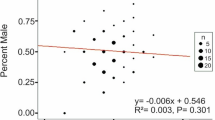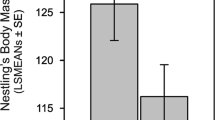Summary
Changes in the sex ratio of juvenile recruits into a population of meadow voles (Microtus pennsylvanicus) were correlated with shifts in the weight and mortality of pups within the population. The biased recruitment of female juveniles in the spring was reflected in differential allocation of energy within the litters, as measured by female pups being heavier than male pups (n=245). In the fall, the shift in recruitment to male juveniles was reflected within litters by male pups being heavier than female pups (n=139). Nestling mortality showed a similar gender bias. Skewed sex ratios were most evident within the litters of larger mothers, indicating the gender bias was not trigered by energy limitations. We postulate that gender differences in social spacing and behavior result in spring/fall fluctuations in the reproductive success of offspring, based on their gender.
Similar content being viewed by others
References
Boonstra R, Rodd FH (1983) Regulation of breeding density in Microtus pennsylvanicus. J Anim Ecol 52:757–780
Chelkowska H (1978) Variations in numbers and social factors in a population of field voles. Acta Theriol 23:213–238
Clutton-Brock TH, Albon SD, Guinness FE (1981) Parental investment in male and female offspring in polygynous mammals. Nature 289:487–489
Getz LL (1972) Social structure and aggressive behavior in a population of Microtus pennsylvanicus. J Mammal 53:310–317
Hansson L (1978) Sex ratio of small mammal populations as affected by the pattern of fluctuations. Acta Theriol 23:203–212
Jannett FJ Jr (1981) Sex ratios in high density populations of the montane vole Microtus montanus and the behavior of territorial males. Behav Ecol Sociobiol 8:297–307
Kalela O (1971) Seasonal trends in the sex ratio of the greysided vole, Clethrionomys rufocanus. Ann Zool Fenn 8:452–455
Kaufman DW, Kaufman GA (1982) Sex ratios in natural populations of Peromyscus leucopus. J Mammal 63:655–658
Krebs CJ, Gaines MS, Keller BL, Myers JH, Tamarin RH (1973) Population cycles in small rodents. Science 179:35–41
Labov JB, Huck UW, Vaswani P, Lisk RD (1986) Sex ratio manipulation and decreased growth of male offspring of prenatally and postnatally undernourished golden hamsters (Mesocricetus auratus). Behav Ecol Sociobiol (in press)
Madison DM (1980) Space use and social structure in meadow voles Microtus pennsylvanicus. Behav Ecol Sociobiol 7:65–71
Madison DM, FitzGerald RW, McShea WJ (1984) Dynamics of social nesting in overwintering meadow voles (Microtus pennsylvanicus): possible consequences for population cycling. Behav Ecol Sociobiol 15:9–17
Madison DM, FitzGerald RW, McShea WJ (1985) A user's guide to the successful radiotracking of small rodents in the field. In FM Long (ed) Proc Fifth Intern Conf Wildl Biotelem, pp 28–39
McClure PA (1981) Sex biased litter reduction in food restriction wood rats (Neotoma floridana). Science 211:1058–1060
McGinley MA (1984) The adaptive value of male-biased sex ratios among stressed animnals. Am Nat 124:597–599
McShea WJ (1985) Influences on the postpartum behavior of female meadow voles in a natural population. Unpubl dissertation, State Univ of New York, Binghamton, pp 113
Michener GR (1980) Differential reproduction among female Richardson's ground squirrels and its relation to sex ratio. Behav Ecol Sociobiol 7:173–178
Myers JH (1978) Sex ratio adjustment under food stress: maximization of quality or numbers of offspring? Am Nat 112:381–388
Myers JH, Krebs CJ (1971) Sex ratios in open and enclosed vole populations demographic implications? Am Nat 105:324–344
Myllymaki A (1977) Demographic mechanisms in the fluctuating populations of the field vole Microtus agrestis. Oikos 29:468–493
Nanmov SP, Gibet LA, Shatlova SP (1969) Dynamics of sex ratio with respect to changes in numbers of mammals. In sian. Zh Obshch Biol 30:673–680 Cited in: Charnov EL (1982) The theory of sex allocation. Princeton University Press, pp 355
Trivers RL, Willard DE, (1973) Natural selection of parental ability to vary the sex ratio of offspring. Science 191:90–91
Twigg GI (1975) Catching mammals. Mammal Review 5:83–100
Webster AB, Brooks RJ (1981) Social behavior of Microtus pennsylvanicus in relation to seasonal changes in demography. J Mammal 62:738–751
Werren JH, Charnov EL (1978) Facultative sex ratios and population dynamics. Nature 272:349–350
Werren JH, Taylor PD (1984) The effects of population recruitment on sex ratio selection. Am Nat 124:143–148
Williams GC (1979) The question of adaptive sex ratio in out-crossed vertebrates. Proc R Soc London Ser B 205:567–580
Author information
Authors and Affiliations
Rights and permissions
About this article
Cite this article
McShea, W.J., Madison, D.M. Sex ratio shifts within litters of meadow voles (Microtus pennsylvanicus). Behav Ecol Sociobiol 18, 431–436 (1986). https://doi.org/10.1007/BF00300518
Received:
Accepted:
Issue Date:
DOI: https://doi.org/10.1007/BF00300518




